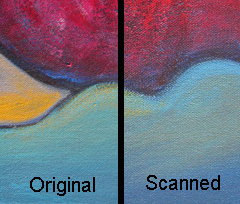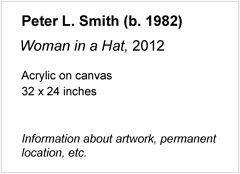| 20 MISTAKES ARTISTS MAKE, AND HOW TO AVOID THEM |
 |
|
This article is intended to serve as a useful resource for art-makers transitioning from amateur to professional, or hobbyist to career artist. Gleaned from research and experience, this combination of art-specific and business-related tips will provide you with some food for thought on your foray into the world of art sales and recognition.
|
SUMMARY
| THE ART ITSELF |
DISPLAYING YOUR ART |
MARKETING YOUR ART |
PUBLIC INTERACTION |
- Cheaping out on materials
- Too many touch-ups
- Never finishing a piece
- Failing to scan or photograph
- Inconsistency of style
- Ceasing professional development
|
- Going frameless
- Bad hang jobs
- Confusing measurements
- Untitled works
- Mishandling the art
|
- Signing with initials
- Chopping prices to sell
- No coherent series
- Abandoning control
- Too much control
|
- Never saying "I'm an artist"
- No online presense
- Ignoring criticism
- Unprofessionalism
|
|
| THE ART ITSELF
|
 |
1. USING LOW-QUALITY MATERIALS
Nothing says to the potential buyer "I don't believe in the value of my work" like obviously thin paints or loose bristles from cheap brushes stuck in the painting.
While inexpensive paints and brushes are a great option for practice and experimenting, they're referred to as "beginner" for a reason. Not only is the lower quality of many cheap art supplies often visible on a finished piece, they are also not intended to last for centuries, or even decades.
If you hope your artwork will one day reach "collectable" status, give it a chance to get there. When you're ready to create a painting (or artwork in any other media) for sale, splurge on high quality canvas stretched on solid wood frames, professional-grade paints, and well-made brushes.
2. NOT KNOWING WHEN TO STOP
Everyone who creates something is guilty of this. When you step back from your nearly completed painting, you will inevitably notice that spot where the color isn't quite right, that section with a bit of canvas showing through, that emply part of the tree that needs just one more tiny, abstract apple.
But if you let yourself get drawn in to painstaking examination of every artwork, you'll never be finished. To an artist, no work is as done as it can be - there will always be something else you could have done to make it better, but you need to draw the line. Not only will this practice put off the start of another potential exhibition piece, but you're bound to eventually over-touch up, and end up with an obvious mistake you can't fix.
3. STARTING AND NOT FINISHING
In the same vein as number 2, a lot of creative types have the tendency to get revved up on a million ideas, but fail to ever finish one. It doesn't matter how amazing, unique, or groundbreaking your thirty-one paintings have been, if they're all piled in a corner half completed, the public will never get the chance to see and appreciate your creative genius.
Maybe you need a second piece on the go for when you get bogged down with the first, but set a limit for yourself and make sure you are finishing those one or two pieces because beginning a third. You'll be glad you did when your Done pile begins to outweigh your Almost Done pile!
4. NOT CREATING A DIGITAL COPY
Never let an artwork leave your home permanently without first having a professional digital reproduction made. Whether you go the photography route or opt for artwork scanning, you'll be glad you sunk a bit of that paycheck into a good digital image.
You never know when you'll want to offer prints of an old original, feature it on your website or portfolio, or be chosen for a retrospective in a magazine. If you have no visual record of your artwork, any of these possibilities becomes impossible.
Taking a snapshot of your art hanging on a white wall, using your point-and-shoot vacation camera or your smartphone will not produce a high quality, printable version of your artwork. Do your beautiful piece justice by getting a professional reproduction.
To learn more about digitally reproducing artwork, see our articles and pages:
Artwork Scanning Calculator
Artwork Scanning vs. Photography
Flatbed Scanners
5. INCONSISTANT VOICE OR STYLE
If you dabble in a variety of mediums, from photography, to acrylic paints, to collage - that's great. But regardless of your materials, array of sizes, or variety of color palates, having a style that is instantly recognizable is a huge step toward "making it" as an artist.
If you are in a group show where six paintings of fifty are yours, guests - both existing supporters and first time viewers - should be able to pick out your pieces from the whole. Just like most visitors to an art gallery can identify the Van Goghs and the Picassos, you want people admiring your art to know it's your art.
Whether you do this with prevalent geometric shapes, uniform, lavender-colored backgrounds, or a distinct way of painting clouds, something in your art should make even the least art-inclined viewer instantly recognize your work.
In additional to pleasing potential buyers, having a consistent voice evident in your artwork will make galleries more likely to take notice. Think of the exhibits you've seen of a single artist's work in a commercial gallery; most of them probably feature a cohesive theme that told you, without even viewing the cards, that all were created by the same hand.
6. IGNORING SKILL-BUILDING
Professional dancers don't just stop learning new steps once they've been paid to perform, and tennis players don't stop working on harder serves just because they won a big match. Likewise, an artist shouldn't stop their artistic education once they've sold a few paintings.
Read books on technique, or learn about old movements or artists whose styles might influence your own. You might not sign up for classes, but surf the web for new tools of the trade, experiment with different materials, and try out techniques you couldn't quite perfect a few months or years ago.
Continuing with the same style might work for a few years, but most successful artists grow and expand their repertoire over time, so you should too!
Kickstart your study with these interesting articles:
Types of Paint
All About Color
Art Movements of the Past 150 Years
|

#1: Use high quality tools

#4: Always make a digital copy
|
| DISPLAYING YOUR ART
|
 |
7. NOT FRAMING FOR-SALE ARTWORK
Though it's tempting to hang priced art without frames, saving you money and probably making transport easier, some professionals say the cons outweigh the pros. When you frame your displayed artwork, you add instant value to the piece, telling the viewer: See, this is something that belongs in a frame, ie: on your wall. That glass and wood or metal, even if it's inexpensive, helps them justify the price tag, too.
By presenting the artwork already in a frame, you also help the viewer to imagine the artwork on their wall. You've saved them a step, where before they had to conjure up a suitable border around the piece before begin envisioning it in different rooms of the house.
That said, however, it's probably best to keep your selling frame simple. Outfitting your charcoal drawing in a gaudy, ornate frame - even if it's exactly the style you'd display - could turn off potential buyers who might love the artwork, but would never hang the frame.
It's even a good idea to offer any prints you plan to sell in plastic sleeves with window mats provided. Though it's an extra cost, it's one less step for the buyer when they get your work home (which means it's more likely to be framed and displayed right away instead of sitting in the bag for a few weeks), and they'll be more willing to pay an extra 5 or 10 dollars when they see they don't have to buy a mat.
So unless your work is intended never to be framed, step it up a professional notch before you display it in the sale space.
Check out our great selection of affordable custom picture frames.
8. POORLY HUNG ARTWORK
Even though the lighting and space isn't your responsibility when you're showing your artwork in public, you still want to make sure it's up to par. The most beautiful painting in the world could be relegated to the unsellable pile if it's hung in a small alcove, improperly lit and maybe a bit crooked.
Every piece in your show should be well-lit, well-labelled, straight, and at the proper height. A lack of any of these factors can unconsciously turn off a buyer who might have salivated over the piece under better circumstances.
Don't be afraid to discuss any concerns with the curator or host of the show. If they're taking a commission, they should be happy to make adjustments that might encourage a sale.
Take a look at our informative article on Art Gallery Lighting.
9. INACCURATE OR CONFUSING DIMENSIONS
Artworks professionally displayed are almost always labelled with the dimensions of the piece, height by width (by depth if required). Though the units vary by location, this is a relatively standard practice. Unless the frame is a steadfast part of the piece, it's size is not included in the measurement.
Be certain your labels are accurate - and that goes for every detail, not just the size. Errors in an artwork label detract heavily from your perceived professionalism, even going so far as to lose you a sale. And if the piece does sell, imagine the buyer's frustration should they get it home to find it doesn't actually fit in the envisioned spot because the true dimensions don't match their requirement.
10. NOT TITLING ARTWORK
Though on trips to art galleries I have regularly seen "Untitled" artworks, or those with nothing written in that space whatsoever, including a title with your artwork is considered evidence of professionalism, lasting importance, and saleability.
Some professionals recommend choosing a name that is relatively straightforward, or at least does not require esoteric knowledge of pop culture or pulp fiction to comprehend. For example, if the artwork in question is a picture of a mountain, "Mt. Rainer at Sunset" is a good choice for a title, while "Raiders of the Lost Ark" might be less so.
11. MISHANDLING YOUR ART
The way you feel about your artwork will be noted by the client. If you treat each painting like a masterpiece worthy of a private collection, it's more likely your potential buyer will feel the same way.
Likewise, if you deliver a purchased piece in a black garbage bag sealed with masking tape and stuffed in the backseat of your car, the buyer is liable to lose a bit of the awe and excitement they felt when originally paying for the painting.
From first brushstroke to final drop off, view and treat your art the way you want others to see it. General appearance aside, not taking proper care of an artwork that has already been paid for could more easily result in an accident that has you handing back the check. Purchase professional-quality portfolios or cases for thicker pieces to use when transporting your art to the studio, gallery, or client.
|

#8: Make sure displayed art is well-lit

#9, #10: label dimensions and title artwork
|
| MARKETING YOUR ART
|
 |
12. SIGNING USING ONLY YOUR INITIALS
According to some pros, signing an artwork with only your initials is a sign that you aren't secure enough or proud enough of your artwork to attribute it to your legal name. It also suggests you haven't nailed down a style, or chosen a name for yourself, which could imply a big shift in future that renders this piece worthless.
To remedy this, whether true or just perception, they suggest pinning down a name once and for all. Sign as Peter L. Smith, Smith, Peter, P.L. Smith, or Peter S., but avoid P.S. In addition to reassuring potential buyers, your visible, readable signature is another step toward #5's goal: it helps make your art instantly recognizable to viewers.
13. LOWERING PRICES TO MAKE THE SALE
Of course it's tempting to drop your advertised price so an undecided interested party will buy it, especially if you've crunched the numbers and know you'll still be making a profit. But cutting prices sets a dangerous precedent.
If word gets around that you regularly lower your original price, prospective buyers will simply hold out until you do what you're known for: offer a discount. It also makes people who would have paid full price question whether your art is really worth that steep, initial price tag.
If you have a system in place to set your prices (for instance, paint cost+canvas cost+however much per hour), you'll feel more secure in the price you've stated, and less willing lower it since you know it's fair. You'll also be able to justify it to a hedging client. Read more about this in our article Pricing Your Artwork.
If you find you're constantly being pressured to lower your price, maybe it's time to consider options for your lower budget clients. Prints of your most popular originals, small originals at a fraction of the cost, even greeting or postcards - small sales add up quickly, and you won't get a reputation for bartering.
14. MAKING TOO MANY ONE-OFFS
This tip goes hand in hand with #5, having a consistent style. It's great to pride yourself on your variety, but if you've never created a series and only offer a mish-mash of one-offs that look nothing like the one before, you might find it difficult to score a return buyer or a gallery exhibit.
Think of that band whose first two albums were played on repeat in your car stereo, but whose third album was so different, you couldn't get through it. People like what they like, and even though you might be drawing in a berth of diverse buyers with your modge podge style, you may find you're not seeing any of them a second time. That often translates to fewer or no gallery shows or collectors.
This is strictly a marketing concept, however. If you really do pride yourself on never making a work of art that looks anything like your other work, and that in itself is your style, then stick with that. You may not see as many return investments, but you'll be staying true to your art.
15. RELYING ON SOMEONE ELSE TO MAKE YOUR SALES
If you're aiming for a career as an artist, you probably have your work in a number of different places; Esty, maybe, as well as scanned images on multiple art print sites, maybe one or two retail stores, and originals hanging at that little gallery downtown.
Even if you've been seeing a good return from one or more of these avenues, you still need to be making connections on your own: keeping in touch with past buyers, networking with other artists, galleries, and collectors who like your style, handing out business cards, applying for shows and grants, and so on.
Don't fall into that "true artist" trap of assuming just because your work is pretty, people will continue to buy and all you have to do is churn out paintings. You need to become a business person, at least in part, unless (or until) you can afford to hire someone to take care of all that for you.
16. NOT RELYING ON ANYONE FOR ANYTHING
On the other hand. a business owner doesn't usually run their corporation entirely on their own, so if you are making a business of your art, you don't have to go it completely solo, either.
There are many things you can take care of - indeed, many things only you can take care of - but don't be afraid to ask for help. Discuss shipping and printing discounts with the company who makes your art prints (learn more about KeenART Media's Pro Account), if you found a reputable shop to display your art, let them handle those specific pieces, enlist willing friends or family members to help you store finished pieces, supplies, or loan you their empty garage as a studio.
You're a business person now, sure, but you must also make time to work on your craft, without stretching yourself so thin you collapse. You might not be able to afford an assistant, but that doesn't mean you can't take assistance where it's available.
|

#12: Sign art with your full name

#13: Don't make a habit of lowering prices
|
| PUBLIC INTERACTION
|
 |
17. NOT IDENTIFYING YOURSELF AS AN ARTIST
When people ask what you do, do you mutter unintelligibly, or just say you're a part-time retail clerk? The first step to becoming a professional artist is seeing yourself as one.
As mentioned above, have business cards made and pass them out when applicable. Don't wait to list art as a hobby - many new acquaintances aren't going to ask. Instead, when asked what you do, say you're a visual artist, a painter, a photographer, or - if you can't quite get the official word out - that you're in the process of building your visual art business.
This pronouncement invites more questions, interest, and who knows - maybe they have an uncle who's a collector or a friend who runs a gallery. And the meek, mild office admin you used to identify as would never have known!
18. LACK OF ONLINE/SOCIAL MEDIA PRESENCE
Maybe you side with the proponents a Twitter-free world, or dumped Facebook when the baby photos became too much. Whatever your reasons for avoiding social media, by doing so you're only holding your art business back.
Everything is online these days, and professionals - whether they're lawyers, writers, accountants, or painters - are pretty much guaranteed to see business advancement by getting in on this accessible, and mostly free, service.
Set up a website showing your portfolio, resume, and contact information for interested buyers. Open an online store on Etsy or a similar site where you can hawk your wares and, if nothing else, have something to show curious people who Google-search your name. Bite the bullet and open a business Twitter or Instagram page, where you post art info, half-finished works, and exhibit dates.
Get out there, because if someone catches your name in passing, they're likely to pull out their phone and look you up. If they find nothing, chances are your name will slip right back out of their mind.
19. IGNORING CONSTRUCTIVE CRITICISM
Compliments are easy to accept and cling to, while criticism is left to slide off, unless it clings to you itself.
Don't let negative feedback get you down, but don't completely brush it off, either. Learn to differentiate between the haters and the knowledgeable sources who have something useful to say; in other words, pick out the constructive criticism from the base insults and use the former to think about your artwork.
You don't have to completely redesign your style, approach, medium, just because a more successful artist suggested it, but if their comment seems good-natured, you owe it to yourself and the future of your art career to take it into consideration.
20. UNPROFESSIONALISM
You might argue that there have been obnoxious, constantly intoxicated, obscenely flamboyant famous artists in the past (not to mention the present), but if you aren't famous yet, you probably don't want to pin your career's future on such uncertainty.
If you want to be taken seriously as an artist, make sales, be invited to appear in shows - act like a serious artist. Make an effort to dress appropriately and act appropriately at public events, don't spend your social media face time bashing other artists or posting wildly controversial statements unrelated to art (open a private, anonymous account if you're itching to do that), and make sure every piece you present or sell is held to a standard that is expected of your own artwork, and your chosen field.
Be professional, and you're more likely to see professional-quality results in your art business endeavors.
|

#17: Identify yourself as an artist
|
|
Working to become a professional artist should be fun, rewarding, and educational. The tips discussed above are useful to consider along your path to financial and artistic success. But don't forget the probable reason you became an artist in the first place; don't let go of that love for the inspiration, the process, and the thrill of the finished piece.
If you have questions about any of our services or products, don't hesitate to contact us. Our knowledgeable staff is always happy to assist with answers, advice, or suggestions.
|
|

|



|
USA Giclee On Canvas, Fine Art Printing - Art Scanning & Reproductions - Handmade Oil Paintings - Custom Wood Panels, Metal Picture Framing - Block/Plaque Mountings, Large Format Dry Mounting & Lamination - Art Supplies: Stretcher Bars, Cradled Wood Panels and Artist Canvas - Collages On Canvas - Plexi/Acrylic Face Mounts - Block Acrylics, Fabric Printing, Dye Sublimation - Cityscape Skyline Prints, Resin, Photo Gifts and more...
|
|
© 2002-2025 - KeenART Media Ltd.
|
|
| |
|

